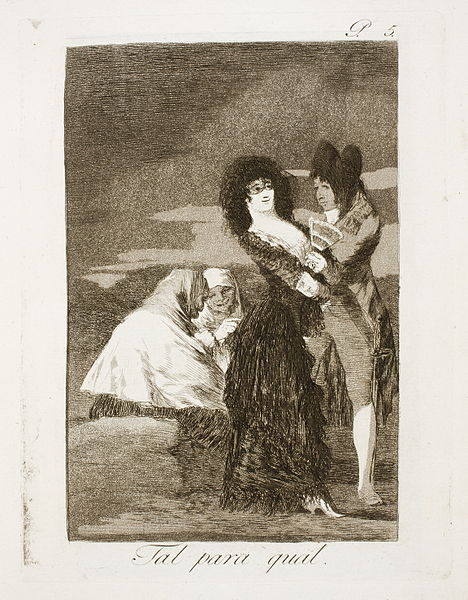"I fell in love with the psychology of Goya and his palette,” wrote brilliant composer-pianist Enrique Granados at the beginning of an evocative paean prefacing his six original Goyescas of 1909-11, finely-wrought gems of the piano repertoire. In love, too, are most of us who have gaped with awe at the astonishing range and careful selection of portraits in the current National Gallery exhibition - one of its best ever, equal in revelation to the recent Rembrandt spectacular.
No-one wants music to distract from the detailed contemplation of all those Spanish nobles, intellectuals and craftsmen; the overload of sound and image is always too much, even when pertinent. But music could have played more of a part in the programme of events associated with the Goya portraits exhibition over the past few months. Just before show’s end this Sunday, though, two young protégés of the Park Lane Group’s quality programme made the resonant best of the Gallery’s domed Room 36 with the complete Goyescas - looked down on by four full-length 18th century portraits, two small but significant Goyas passed on the way to take our (free) seats.
 Exhibition curator Xavier de Bray gave us an affectionate introductory sketch of Goya’s relationship to music, cruelly cut short by deafness in 1793; there was the poignant image of the artist putting his hands on a keyboard to see if he could feel any reverberations, but he couldn't. How he would have loved the layers of sound and meaning, and ultimately the profundity, in Granados’s much later homage.
Exhibition curator Xavier de Bray gave us an affectionate introductory sketch of Goya’s relationship to music, cruelly cut short by deafness in 1793; there was the poignant image of the artist putting his hands on a keyboard to see if he could feel any reverberations, but he couldn't. How he would have loved the layers of sound and meaning, and ultimately the profundity, in Granados’s much later homage.
Only two of the six pieces relate directly to a Goya work (a seventh study, “El pelele” refers to the well-known painting of the straw man thrown up in the air from a blanket, but that’s only occasionally heard in the context of the official Books One and Two, and wasn’t included). Gamal Khamis rolled majestically on to the scene with the rich sonorities of “Los requiebros” (“The compliments”), based on Los Caprichos No 5 (pictured above), where affectation and mimicry share the frame.
 The left hand register resounded in the not too reverberant space; the right could sound a bit tinny, a fault to be laid, I fancy, not with Khamis but with the Yamaha piano (a familiar shortcoming, though of course Richter played a Yamaha in a very exclusive concert here). Nocturnal dissolves both here and in “Colloquio en la reja” (“Conversation at the window”), with its last 30 seconds encapsulating all the magic of Spanish night and black silks which even Debussy couldn’t surpass, were exquisitely controlled.
The left hand register resounded in the not too reverberant space; the right could sound a bit tinny, a fault to be laid, I fancy, not with Khamis but with the Yamaha piano (a familiar shortcoming, though of course Richter played a Yamaha in a very exclusive concert here). Nocturnal dissolves both here and in “Colloquio en la reja” (“Conversation at the window”), with its last 30 seconds encapsulating all the magic of Spanish night and black silks which even Debussy couldn’t surpass, were exquisitely controlled.
Finding the right levels of filigree around the inner parts of Granados’s complex style, developing the Chopin/Liszt tradition, may be a lifetime’s work, and the sheer virtuosity of ornamentation in “El fandango de candil” (“The fandango by candlelight”) gave Khamis (pictured above) some problems of articulation. But his sheer poetry re-emerged in the wistful beauty of the best-known number, “Complaints or the maiden and the nightingale”, meltingly rounded off by Granados’s nocturnal birdsong.
 Its dark counterpart, the very soul of the Goyescas which builds upon what has gone before it, comes in “El amor y la muerte” (“Love and Death”), complementing the Capricho where a soldier dying from a duel is desperately held close by the girl whose love he has thrown away. Joseph Houston (pictured left) was the lucky interpreter of what has to be among the greatest deep-veined masterpieces of the piano literature, the sinking sequences and heartbreaking snatches of lovesong touching depths rather than evoking atmospheres. The virtuosity here was writ large, big delivery counterbalanced by the perfect, haunting sense of life ebbing away. This is the one piece of the six which you wish would go on for longer rather than stop a little bit sooner. I'd give up any of Liszt's more pretentious piano pieces for this.
Its dark counterpart, the very soul of the Goyescas which builds upon what has gone before it, comes in “El amor y la muerte” (“Love and Death”), complementing the Capricho where a soldier dying from a duel is desperately held close by the girl whose love he has thrown away. Joseph Houston (pictured left) was the lucky interpreter of what has to be among the greatest deep-veined masterpieces of the piano literature, the sinking sequences and heartbreaking snatches of lovesong touching depths rather than evoking atmospheres. The virtuosity here was writ large, big delivery counterbalanced by the perfect, haunting sense of life ebbing away. This is the one piece of the six which you wish would go on for longer rather than stop a little bit sooner. I'd give up any of Liszt's more pretentious piano pieces for this.
The encounter with death becomes a valse triste with flashes of brilliance in the concluding “Spectral Serenade”, a fitting epilogue and an uncomfortable one in the light of Granados’s untimely end; he and his wife were drowned in 1916 shortly after the premiere of the operatic Goyescas when their cross-channel ferry was torpedoed. Yet he had written that the pianistic Goyescas was “a work for the ages, I am convinced of that”, and this all too rare performance of the entire sequence – the perfect marriage of an evocative venue and the PLG set-up – left us in no doubt that he was right.
Next page: watch a performance of "El amor y la muerte" from GoyescasDomenico Codispoti plays "El amor y la muerte" from Granados's Goyescas















Add comment